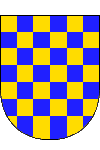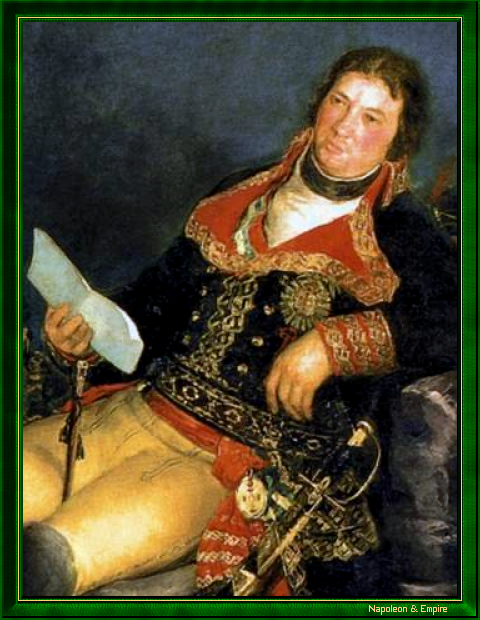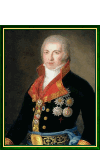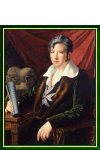Manuel Godoy y Alvarez de Faria
Prince of the Peace and Bassano, Duke of Alcúdia and Sueca

Manuel de Godoy y Álvarez de Faria was born into a poor family in Badajoz (Extremadura) on May 12, 1767. Following the example of his older brother, he joined the Royal Guard at the age of seventeen, and was assigned to the Bodyguard in Madrid.
His good manners, education, presence and bearing soon brought him to the attention of the Prince of Asturias (the future Charles IV), whose affection and friendship he won, and his wife Marie-Louise de Parme, whose lover he became.
As a result, Charles IV's accession to the throne in December 1788 brought Godoy an impressive series of promotions and honors: supernumerary cadet at the royal palace, cavalry colonel in May 1789, knight then commander of the Order of Santiago in November 1789 and August 1790, aide-de-camp in February 1791, gentleman of the court the following month, lieutenant general and knight Grand Cross of the Order of Charles III in July 1791.
In November 1792, Charles IV appointed Godoy − aged just twenty-five − Prime Minister, replacing the Count of Aranda. He also created him Duke of Alcudia with the Grandness of Spain, decorated him with the Golden Fleece and, in the spring of 1793, appointed him Commander-in-Chief.
Godoy had to govern under particularly difficult conditions for the kingdom. He tried unsuccessfully to save Louis XVI, then entered into conflict with France, the Convention having declared war on Spain in March 1793. Initial victories were followed by clear setbacks, leading to the signing of the Treaty of Basel on July 22, 1795, which earned him the title of Prince of Peace (Príncipe de la Paz) and the Spanish Grandness of the First Class.
Godoy's private life saw the coexistence of a long-term relationship with his mistress Josefa Pepita Tudó (Francisco Goya's "Maja"), a no less enduring assiduity with Queen Marie Louise de Parme, and a marriage (on the Queen's initiative) in October 1797 to Princess María Teresa de Bourbon, daughter of the Count of Chinchon and first cousin of Charles IV.
This marriage produced an only daughter, Luisa Carlota Manuela de Godoy, while Pepita Tudó gave him two sons: Manuel de Godoy di Bassano y Tudó (1805-1871) and Luis de Godoy (1807-1818). Queen Marie-Louise, for her part, gave birth in 1794 to the infant François-de-Paule of Spain (younger brother of Prince Ferdinand of Asturias), whose resemblance to Manuel Godoy is uncanny...
At home, Godoy tried to raise Spain's economic level and reduce the influence of the clergy, which earned him many enmities. In foreign relations, he governed as a loyal ally of France, strengthening Franco-Spanish ties with the Treaty of San Ildefonso on August 19, 1796 (not to be confused with the Treaty of October 1, 1800). However, weakened by the naval defeat at Cape St. Vincent on February 14, 1797, and facing incessant intrigue (stirred up by the Directoire), he was forced to resign on March 28, 1798.
Well-regarded by the First Consul Napoleon Bonaparte, Godoy was again appointed Prime Minister in 1801, and continued his policy of alliance with France by commanding in chief the Spanish army that invaded Portugal, a traditional ally of England: this was the "Orange War" from May 16 to June 6, 1801, which led to Portugal's surrender.
However, Spain's interests were not taken into account in the 1802 Amiens Peace Treaty, and internal opposition to King Charles IV (supported by his son Ferdinand, Prince of Asturias) grew.
While Godoy took advantage of the peace to continue administrative and economic reforms, the English attack on four Spanish frigates near Cadiz on October 1, 1804 forced him to declare war on England. Finally, on October 21, 1805, a major military setback added to these difficulties: the Spanish fleet, allied to the French fleet, was annihilated by the English navy at Trafalgar...
Despite this, Godoy's good relations with Napoleon did not cool, and led to the Treaty of Fontainebleau on October 27, 1807, which organized the dismemberment of Portugal to the benefit of Spain, France... and Godoy himself (he was promised the south of Portugal, which became the principality of the Algarves).
But domestic difficulties were growing: in March 1808, the people of Madrid overthrew Charles IV in favor of his son Ferdinand, and demanded Godoy's head. Napoleon I had him taken away from the people by Joachim Murat, who took him to France.
Godoy represented Charles IV at the ensuing Bayonne interview, where the monarch renounced his throne, as did his son Ferdinand, who had to make do with that of Liguria. The King of Spain was henceforth called Joseph Bonaparte, and the Spanish people's mass uprising put an end to the Franco-Spanish alliance.
Manuel Godoy's political career was over at the age of forty-one. He shared his exile in France with Charles IV and Marie-Louise de Bourbon-Parme, his daughter Luisa Carlota Manuela, his mistress Pepita Tudó and their son Manuel, successively in Fontainebleau, Compiègne, Aix-en-Provence, then Marseille from 1808 to 1812. In July 1812, the small group moved to Rome, to the Palazzo Barberini.
The restoration of Ferdinand VII to the Spanish throne in April 1814 forbade Godoy any idea of returning to Spain; worse still, Pope Pius VII exiled Godoy and Pepita Tudó to Pesaro. Emperor Francis I of Austria, for his part, refused Godoy's request for asylum in Vienna.
Manuel was able to return to Rome, but not Pepita, who was also rejected in Genoa and Livorno, finding refuge in Pisa. They lost Luis, their youngest son, in 1818. Manuel himself came close to succumbing to a bout of malaria. Finally, the deaths within three weeks of each other of Marie-Louise de Bourbon-Parme and Charles IV in January 1819 deprived Godoy of his only support.
In 1828, Godoy's legitimate wife, María Teresa de Bourbon, died in Paris, enabling Manuel to marry Pepita in February 1829. The couple settled in Paris in 1832, living frugally on a pension of five thousand francs granted by the French king Louis-Philippe I.
The death of Ferdinand VII in 1833 enabled Godoy to publish his memoirs, and his wife to return to Spain. In 1847, the Spanish government returned part of Godoy's property and restored his titles.
Manuel Godoy died in Paris on October 4, 1851. Buried in the church of Saint-Roch, his body was transferred the following year to the Père-Lachaise cemetery (45th division) , thanks to the generosity of one of his bankers.
"Manuel Godoy y Alvarez de Faria, Principe de la Paz" by Francisco José de Goya y Lucientes (Fuendetodos 1746 - Bordeaux 1828).

Napoleon held Godoy in high esteem, calling him a man of genius.
Other portraits

"Manuel Godoy y Alvarez de Faria, Principe de la Paz" by Agustin Esteve y Marqués (Valencia 1753 - Madrid 1820 or 1830).

"Don Manuel Godoy y Alvarez de Faria, Principe de la Paz" by José de Madrazo y Agudo (Santander 1781 - Madrid 1858).